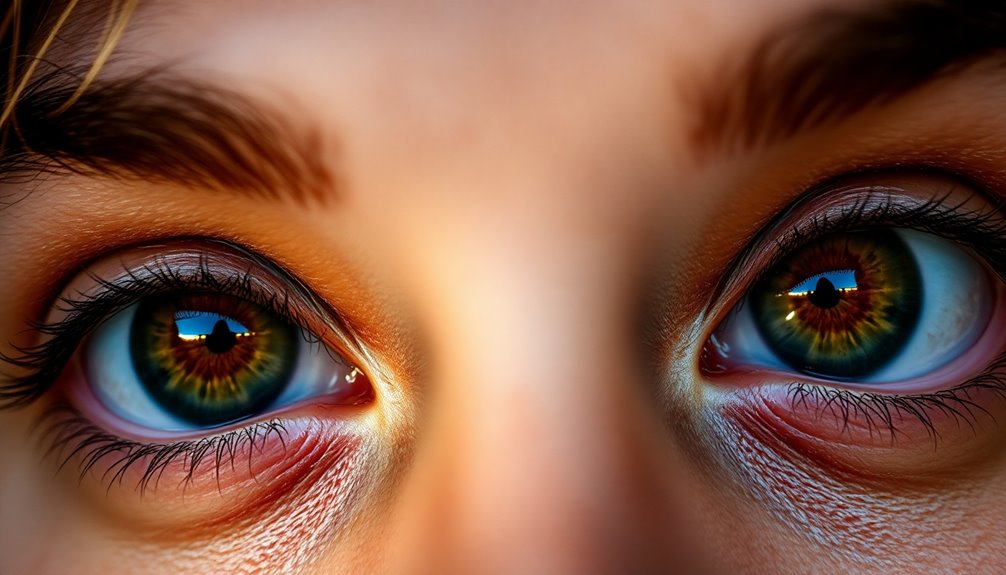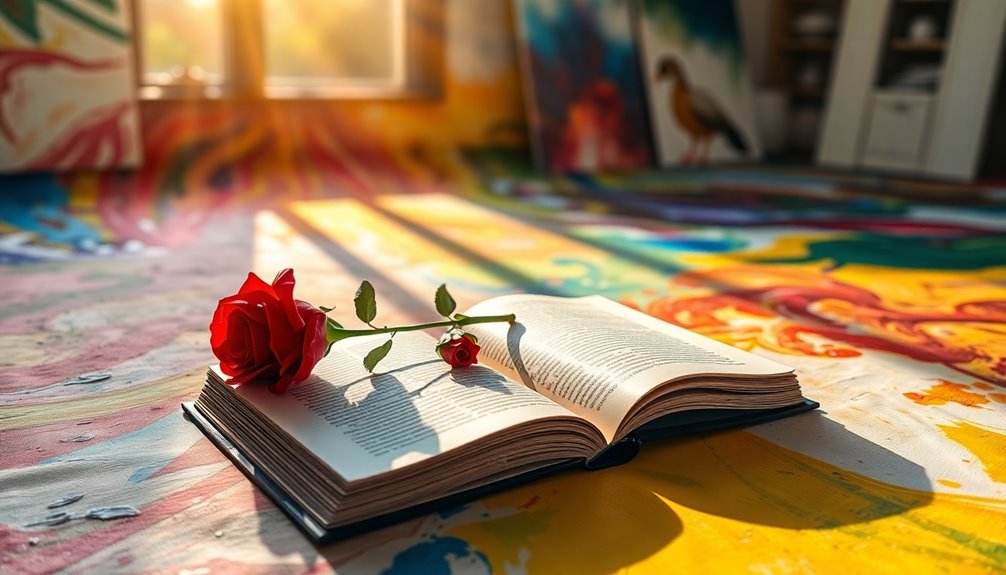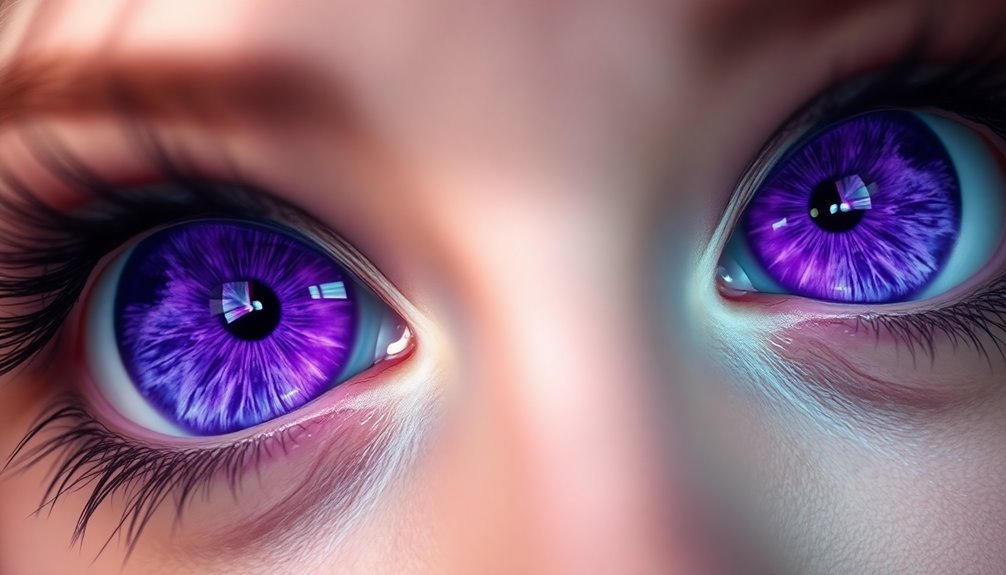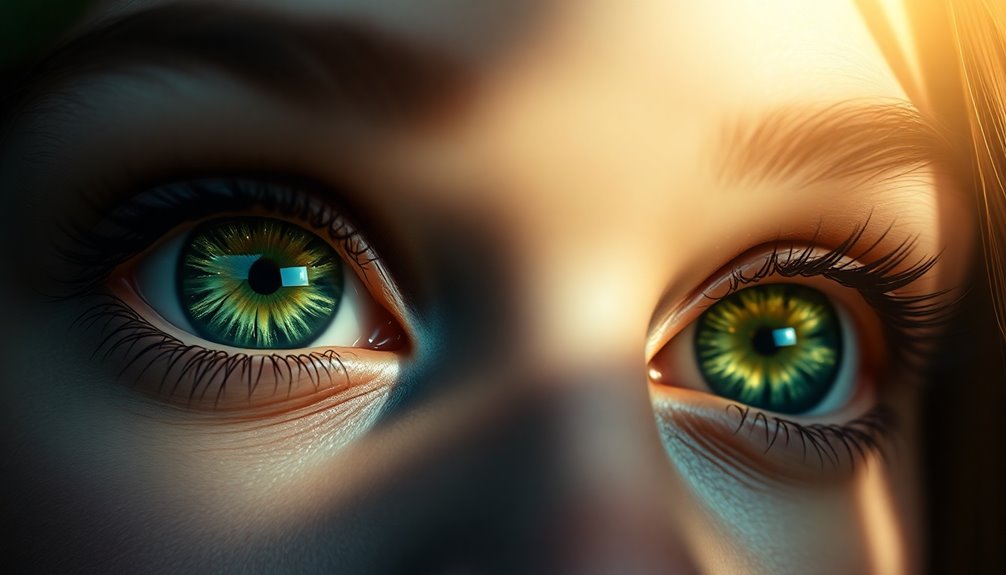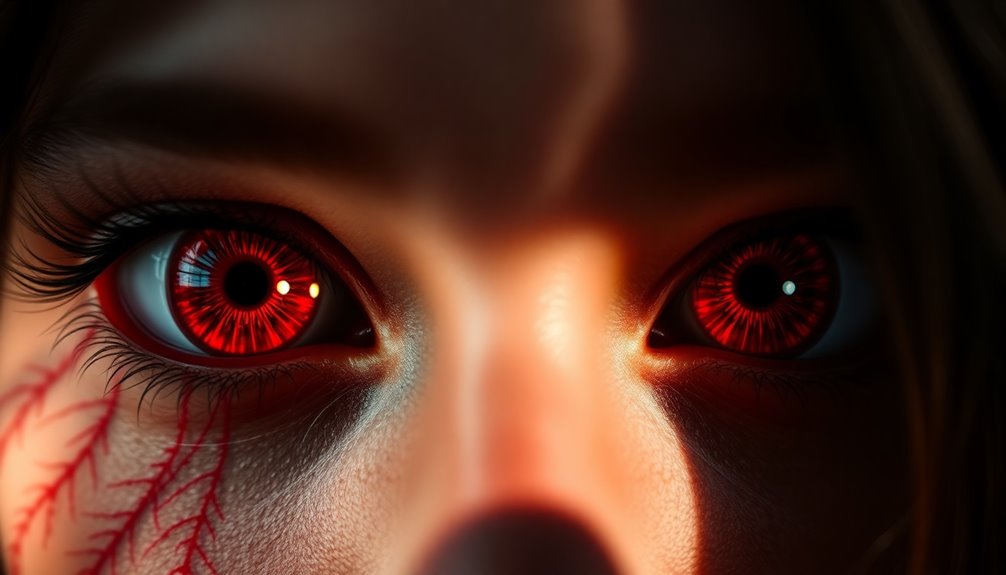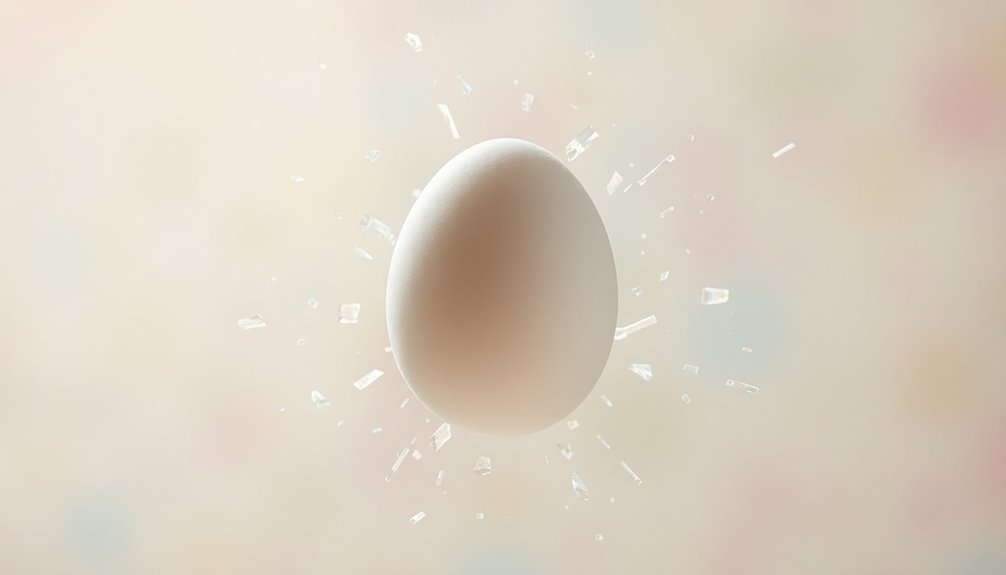Hazel eyes carry a deep spiritual meaning, blending intuition, adaptability, and emotional intelligence. You might notice how their unique color shifts reflect your inner complexity. People with hazel eyes often show a profound connection to nature and its cycles, symbolizing good fortune and wisdom. Culturally, they're seen as approachable yet mysterious, enhancing your trustworthiness and relationship-building skills. There's also a connection to the Third Eye Chakra, which can enhance your intuitive abilities. As you explore this multifaceted insight, you'll uncover even more about the power behind hazel eyes and what they reveal about you.
Key Takeaways
- Hazel eyes symbolize intuition and inner wisdom, reflecting a deep self-awareness and emotional intelligence in individuals.
- The color's adaptability represents the ability to navigate life's complexities, fostering deeper connections with others.
- Culturally, hazel eyes are viewed as symbols of good fortune and prosperity, embodying beauty and complexity in literature and art.
- They are strongly linked to the Fire element in astrology, representing passion and an adventurous spirit, particularly in signs like Aries, Leo, and Sagittarius.
- The connection to the Third Eye Chakra enhances psychic potential and self-discovery, encouraging ongoing personal growth and spiritual exploration.
Definition of Hazel Eyes
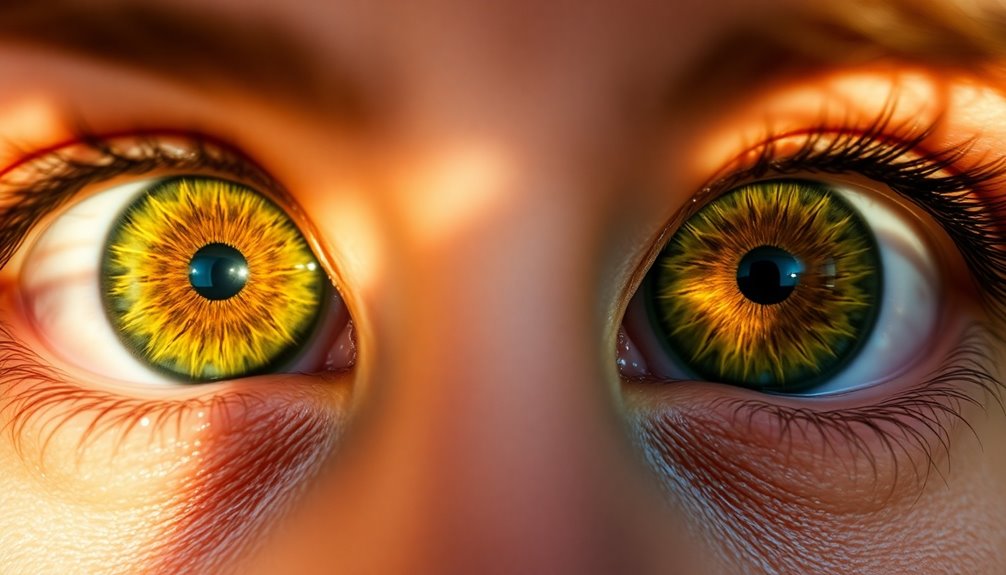
Hazel eyes, with their striking blend of green, brown, and gold hues, create a fascinating and unique appearance that's hard to ignore. This eye color isn't just a single shade; it's a dynamic combination that often shifts based on lighting and surroundings. You might notice how the green can emerge more prominently in bright light, while the brown adds warmth and depth in dim conditions. This enchanting interplay makes hazel eyes truly distinctive.
Compared to the more common blue and brown eyes, hazel eyes are relatively rare, which only adds to their allure. When you see someone with hazel eyes, there's often a sense of curiosity and fascination surrounding their gaze. This unique blend of colors isn't confined to one ethnic group; you'll find individuals with hazel eyes across various backgrounds, showcasing a rich tapestry of genetic diversity.
Culturally, hazel eyes have been interpreted in literature and art as symbols of mystery and depth, further enhancing their intrigue.
Spiritual Significance
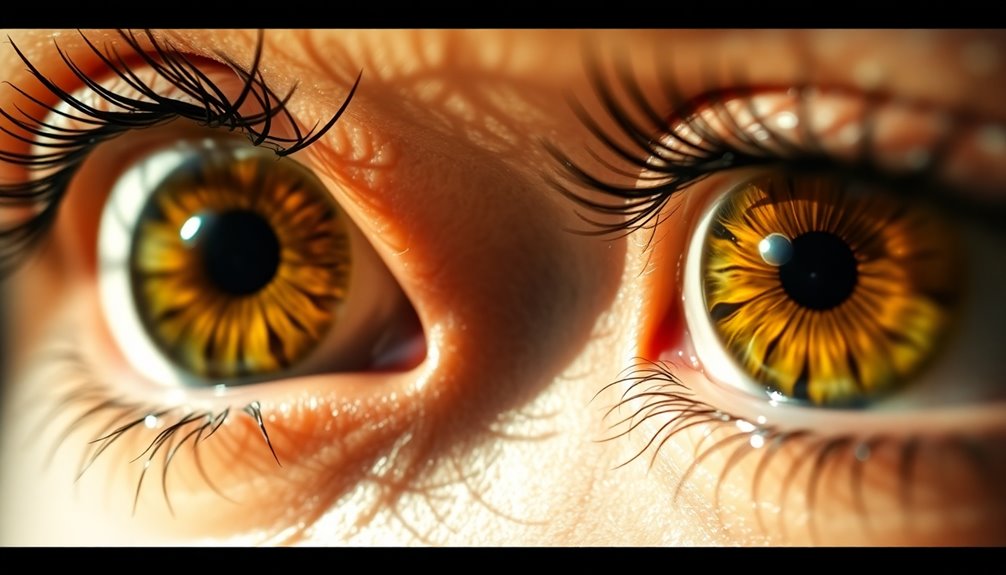
Hazel eyes carry a unique spiritual significance that reflects your intuition and inner wisdom.
This balance and adaptability allow you to navigate life's twists and turns with creativity and ease.
Furthermore, the connection to nature embodied in hazel eyes enhances your artistic expression and spiritual growth.
Intuition and Inner Wisdom
Eyes often reveal more than just what we see; they can reflect deep intuition and inner wisdom. If you have hazel eyes, you might feel a profound connection to your inner self, guiding you through life's complexities. The unique blend of brown, green, and gold hues in your eyes symbolizes your adaptability, allowing you to navigate emotional nuances with grace and insight.
This adaptability enhances your spiritual awareness, helping you perceive the world in a richly textured way. You likely find that your intuition often speaks to you in subtle whispers, guiding your decisions and creative expressions. The shifting colors within your gaze mirror the dynamic nature of your intuitive abilities, allowing you to respond fluidly to various situations.
Moreover, spiritual traditions celebrate hazel eyes as a beacon of creativity. This artistic essence can manifest in your thoughts, actions, and interactions, reflecting your inner wisdom. Trusting your intuition can lead you to deeper connections with others and the world around you.
Embrace the gifts of your hazel eyes, and let them illuminate your path toward greater understanding and self-discovery.
Balance and Adaptability
The unique colors in your gaze embody a remarkable balance and adaptability that influences how you navigate life. Hazel eyes symbolize a blend of versatility, allowing you to adjust to various situations with ease. This adaptability isn't just a trait; it reflects your ability to connect with those around you, enhancing your communication skills and fostering relationships.
In a spiritual context, your hazel eyes signify a harmony between physical and spiritual dimensions, grounding you while also encouraging your creative expression. This duality enriches your life, as you can draw inspiration from both the tangible world and your inner thoughts. Your creativity shines through in everything you do, making you not only adaptable but also a catalyst for artistic expression.
Culturally, hazel eyes are viewed as a sign of good fortune, further emphasizing your unique position in life. People often see something mystical in your gaze, as if you possess deeper insights that guide your journey.
Embrace this spiritual significance; your balance and adaptability are gifts that help you navigate life's challenges with grace.
Connection to Nature
Many people with hazel eyes feel a profound connection to nature, reflecting a spiritual bond that goes beyond mere appearance. This deep connection symbolizes a balance between the physical and spiritual domains, allowing you to appreciate the beauty around you.
The unique blend of colors in your hazel eyes—green, brown, and gold—illustrates your adaptability and versatility, traits that align closely with the natural world. Your hazel eyes aren't just a physical attribute; they also signify heightened intuition. This enables you to sense the subtleties of your environment, enhancing your experiences in nature.
Consider the following mystical qualities associated with hazel eyes:
- Adaptability: Just like nature's shifting cycles, your eyes can appear to change color, reminding you of life's fluidity.
- Intuition: You possess an innate ability to connect with the earth and its elements, allowing for a deeper understanding of your surroundings.
- Good Fortune: In many cultures, hazel eyes are seen as a sign of luck, reinforcing your spiritual connection to the natural world.
Embrace these qualities, as they enrich your relationship with nature.
Cultural Interpretations
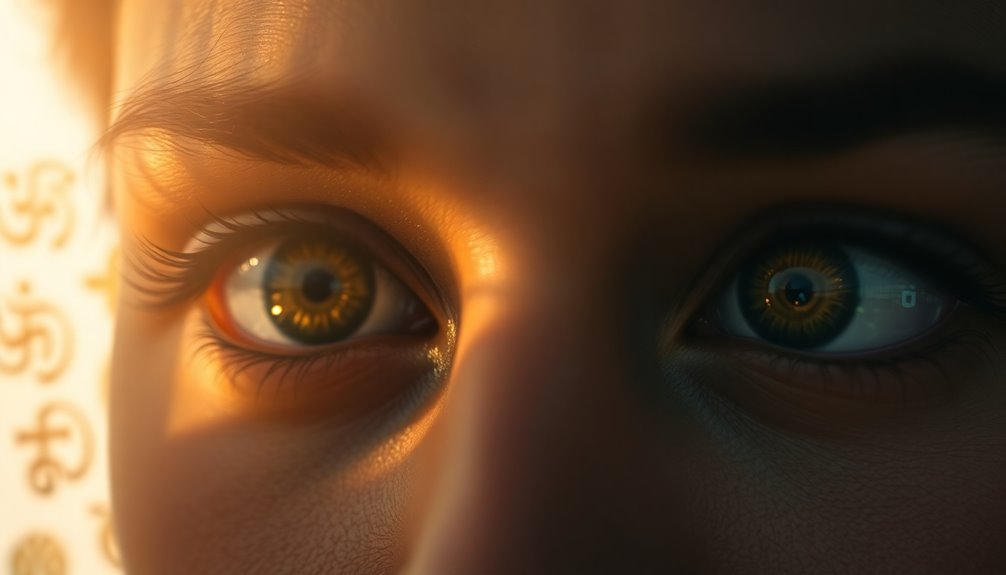
Culturally, hazel eyes often carry a reputation for good fortune, symbolizing luck and prosperity across various traditions. Many believe that those with hazel eyes possess mystical qualities that connect them to the spiritual domain. This connection isn't just about luck; it suggests a deeper understanding of the mysteries of life.
In literature, characters with hazel eyes frequently embody beauty and fascination, capturing the reader's imagination. Their allure stems from the complexity of their gaze, reflecting a multifaceted nature that intrigues both authors and audiences alike.
Art and poetry also celebrate hazel eyes, using this eye color to convey depth and richness in human experience. They represent adaptability and a strong bond with nature, signifying an ability to harmonize with the environment.
In various cultures, people with hazel eyes are often seen as wise and insightful individuals, embodying a unique blend of traits that make them both approachable and enigmatic.
Whether viewed through the lens of folklore or modern interpretations, the cultural significance of hazel eyes remains profound, revealing the intricate tapestry of beliefs surrounding this enchanting eye color.
Psychological Associations
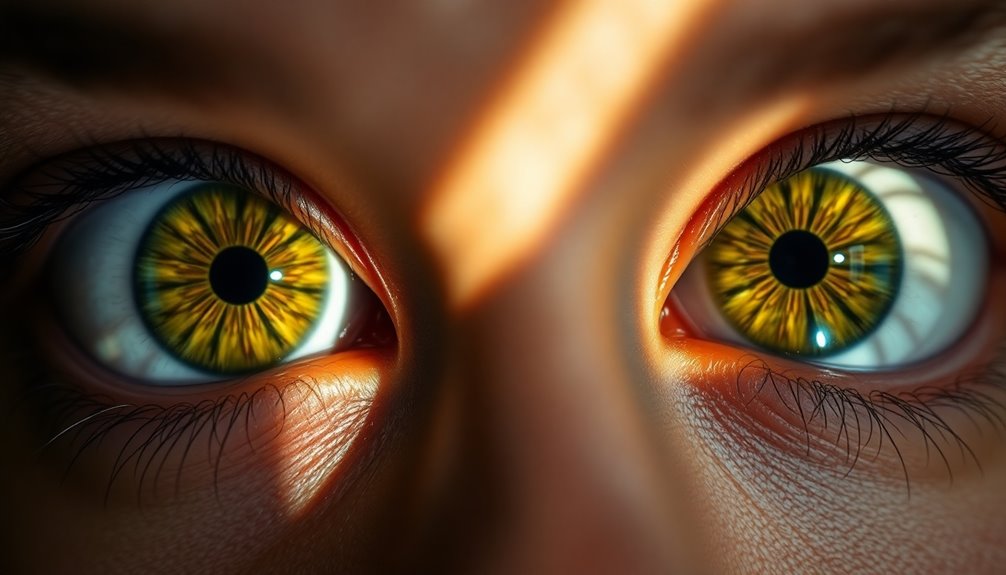
Hazel eyes not only carry cultural significance but also have intriguing psychological associations. If you have hazel eyes, you might notice that people perceive you in specific ways. Research suggests that individuals with this eye color often display higher emotional intelligence, allowing for deeper connections and empathy with others.
Here are a few key psychological associations tied to hazel eyes:
- Trustworthiness: You may find that others see you as reliable and dependable, which can help build strong relationships.
- Adaptability: Your ability to navigate various social situations with ease reflects your versatile nature, making you more approachable.
- Complex Personality: The unique color variation of hazel eyes often suggests depth, hinting at a multifaceted character.
These associations can enhance your social interactions and help create a warm, inviting atmosphere around you.
Whether you're meeting new people or strengthening existing bonds, your hazel eyes play a significant role in how others perceive and connect with you.
Embrace this unique aspect of your personality, as it can lead to enriching experiences and meaningful relationships.
Myths and Misconceptions
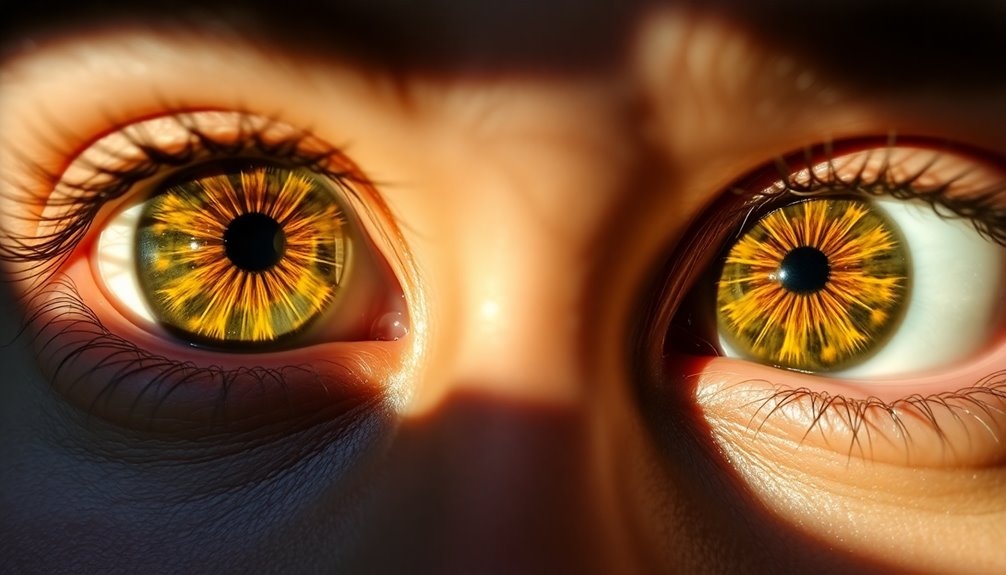
What misconceptions surround hazel eyes that you might've encountered? One common myth is that hazel eyes are merely a result of mixed ancestry. In reality, they represent a unique color variation, with no two pairs being identical.
You may also hear claims that hazel eyes can predict personality traits or even fate. However, these assertions lack scientific backing and are often just anecdotal.
Another misconception suggests that individuals with hazel eyes are more sensitive to light. In truth, sensitivity varies among people, regardless of their eye color.
Some might believe hazel eyes lack depth compared to other colors, but they're often celebrated for their vibrant and changing hues that can shift with lighting and surroundings.
Lastly, there's a prevalent belief linking hazel eyes to witchcraft or magic. This notion primarily arises from cultural folklore rather than any factual basis.
Understanding these myths and misconceptions can help you appreciate the beauty of hazel eyes without falling prey to unfounded beliefs.
Astrological Connections
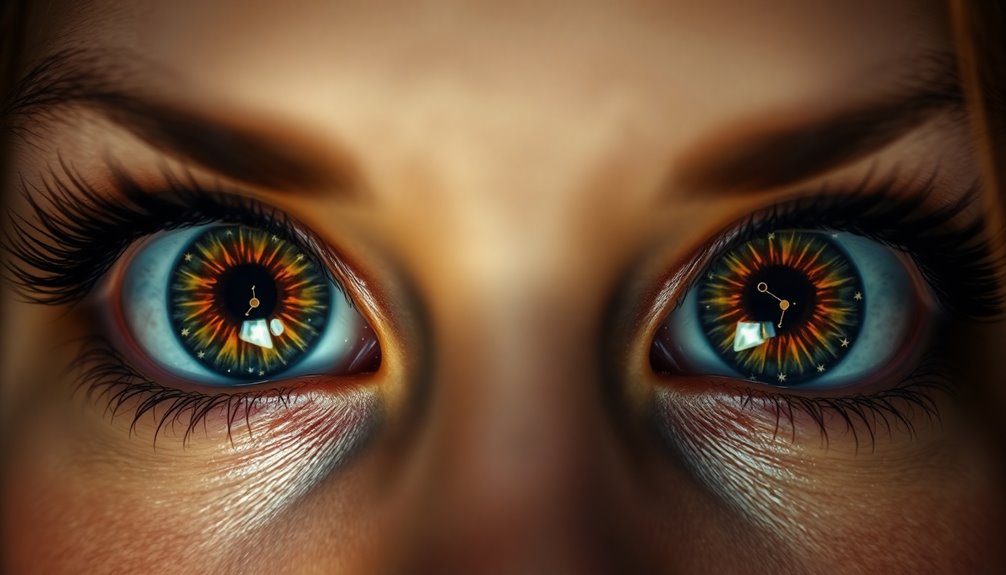
If you have hazel eyes, you might find a strong connection to the Fire element in astrology, which fuels your passion and drive for growth.
Your eye color could also align with zodiac signs like Aries, Leo, and Sagittarius, reflecting your adventurous spirit.
Embracing these astrological influences may open up new opportunities for spiritual growth and creativity in your life.
Zodiac Signs Influence
The deep, enchanting hues of hazel eyes often reflect a rich tapestry of astrological influences, particularly from the Fire Element. If you have hazel eyes, you might resonate with the dynamic qualities of certain zodiac signs, especially those ruled by fire, such as Leo and Sagittarius. These signs embody adventure and passion, mirroring your desire for spiritual growth.
Your hazel eyes may also showcase the adaptability linked to mutable signs like Gemini and Virgo, emphasizing your ability to navigate various life situations with ease. This versatility contributes to your multifaceted personality, revealing different layers of your character.
Consider these traits associated with your hazel eyes and zodiac influences:
- Creativity: You're likely brimming with innovative ideas and artistic flair.
- Enthusiasm: Your passionate approach to life can inspire those around you.
- Adaptability: You can adjust to change, making the most of every situation.
Ultimately, the unique blend of colors in your hazel eyes symbolizes the fusion of personal traits from various astrological influences, enhancing your journey toward self-discovery and spiritual growth.
Fire Element Association
Embodying the essence of the Fire Element, hazel eyes ignite a sense of passion and adventure within you. This vibrant connection fuels your determination to chase new experiences and embrace life to the fullest. The Fire Element symbolizes not just intensity, but also creativity, guiding you on your spiritual journey with enthusiasm and zest.
When you look into the depths of your hazel eyes, you may notice traits like adaptability and a strong desire for self-expression. These qualities align seamlessly with the transformative nature of the Fire Element. You're not just a passive observer; you feel compelled to inspire change, both in yourself and those around you.
As you embrace the fiery qualities associated with hazel eyes, you can maintain a positive attitude, even during challenges. This resilience is a powerful ally on your spiritual journey, helping you navigate obstacles with grace and confidence.
With every glance into the mirror, you're reminded of the unique passion that fuels your life, urging you to explore, create, and evolve. Ultimately, your hazel eyes serve as a brilliant reflection of your inner fire, guiding you toward a life rich in meaning and purpose.
Spiritual Growth Opportunities
Embracing the astrological connections linked to hazel eyes opens up a world of spiritual growth opportunities. As someone with hazel eyes, you may find that your intuitive abilities are heightened, allowing for deeper insights into your life and surroundings. This connection to the Third Eye Chakra can enhance your psychic potential, guiding you on a path of self-discovery and personal empowerment.
Consider these aspects as you explore your spiritual journey:
- Adaptability and Versatility: Hazel-eyed individuals often embody traits that help you navigate change, encouraging growth and transformation. Engaging in mindfulness practices can further support your adaptability during these transitions. Additionally, maintaining a high vibrational energy can greatly assist in overcoming obstacles and embracing new opportunities. It is essential to establish clear goals to guide your progress and reinforce your adaptability. Furthermore, cultivating an understanding of renewable energy sources may inspire you to align your lifestyle with sustainable practices that reflect your adaptability.
- Creativity: Your hazel eyes may spark a desire for artistic expression, inspiring you to tap into your imaginative side.
- Passion for Life: The Fire Element connection fuels your enthusiasm, motivating you to pursue your dreams and embrace new experiences.
In addition, nurturing your mental health through practices such as mindfulness can significantly enhance your journey of self-discovery and spiritual growth.
Chakra Connections
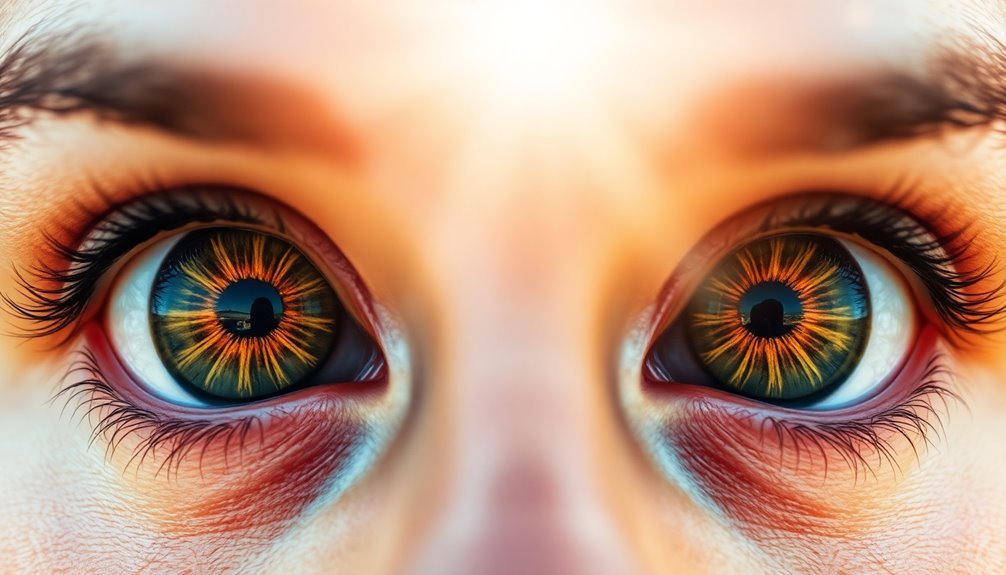
How do hazel eyes reflect deeper spiritual connections? Those with hazel eyes often find themselves maneuvering a unique interplay between the Third Eye Chakra and the Solar Plexus Chakra.
An unbalanced Third Eye Chakra can signify heightened intuition and psychic abilities, revealing the potential for deeper spiritual understanding. However, this requires balancing to enhance clarity of thought and strengthen your connection to inner wisdom.
At the same time, your Solar Plexus Chakra might be underactive, indicating a need for empowerment. This chakra is essential for cultivating personal power and self-confidence. Embracing practices that support this chakra can help you assert your identity and foster a stronger sense of self.
The dynamic nature of hazel eyes encourages you to continually explore both the Third Eye and Solar Plexus Chakras. This ongoing exploration fosters adaptability and personal growth, enriching your spiritual journey.
Elemental Associations
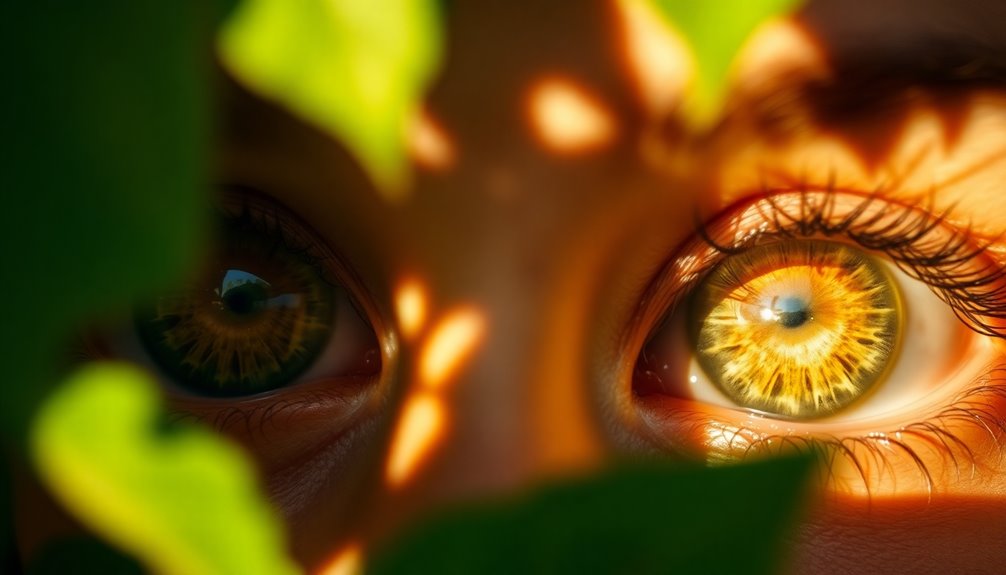
Throughout history, hazel eyes have been linked to the Fire Element, which symbolizes a deep passion for life and a zeal for new experiences. This elemental association enhances your ability to focus on spiritual goals, helping you maintain a positive attitude even during challenges.
The dynamic nature of your hazel eyes suggests a strong connection to change and transformation, emphasizing the significance of adaptability in various aspects of life.
Embracing the elemental qualities of hazel eyes can lead to:
- Personal Growth: The fire within encourages you to push beyond your limits and explore new horizons.
- Creativity: Your adaptability fuels imaginative thinking, allowing you to approach problems from fresh perspectives.
- Resilience: The passion associated with fire helps you bounce back from setbacks, turning obstacles into opportunities for transformation.
Frequently Asked Questions
What Does "Hazel Eyes" Mean Spiritually?
Hazel eyes carry a rich spiritual significance. They symbolize a unique blend of intuition and adaptability, reflecting your ability to navigate both the physical and spiritual domains.
You might find that your hazel eyes connect you to nature, enhancing your creativity and emotional intelligence.
This eye color also represents passion and personal growth, suggesting you have a deep understanding of others' feelings, making you empathetic and insightful in your interactions.
What Is the Significance of Hazel Eyes?
When you look into hazel eyes, you're not just seeing a color; you're witnessing a dance of hues that reflects adaptability and warmth.
These rare eyes often carry a sense of intuition and emotional depth, making you feel drawn to their gaze.
People with hazel eyes tend to embody a unique blend of traits, suggesting they possess both a strong connection to nature and a vibrant spirit, enriching their interactions with the world around them.
What Is the Folklore About Hazel Eyes?
Folklore about hazel eyes often paints a picture of enchantment and allure.
You might find that many cultures see hazel-eyed individuals as bearers of good fortune and prosperity.
These eyes connect you to nature, suggesting a bond with the earth.
Some tales even describe those with hazel eyes as protectors, nurturing harmony around them.
Additionally, your creativity and sensitivity to beauty can shine through, making you a source of inspiration for others.
What Does Hazel Eyes Say About Me?
Hazel eyes say a lot about you. They reflect your versatility and adaptability, showcasing a personality that's open-minded and adventurous.
You likely embrace new experiences and are skilled at reading social cues, which helps you communicate effectively.
People see you as mysterious yet approachable, with a deep emotional intelligence that enhances your relationships.
Your unique gaze hints at confidence and a strong sense of self, inviting others to explore the depths of your character.
Conclusion
In exploring the spiritual meaning of hazel eyes, you've uncovered a treasure trove of insights. Just like a kaleidoscope, hazel eyes reflect a spectrum of emotions and depths, inviting you to see beyond the surface. They embody a unique blend of strength and mystery, reminding you of the beauty found in diversity. Embrace this multifaceted gaze, as it not only enriches your understanding of yourself but also deepens your connections with others on this shared journey of life.

